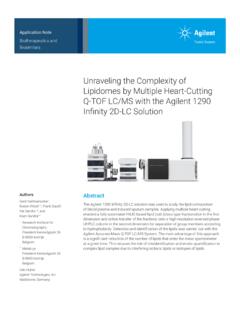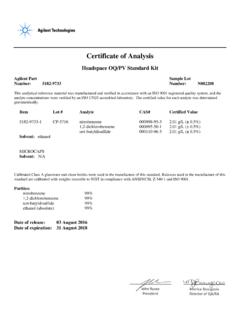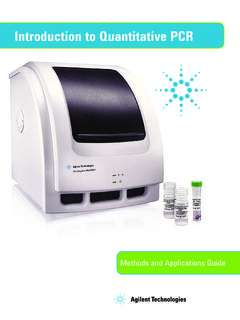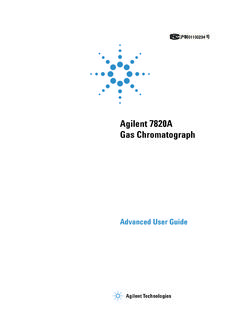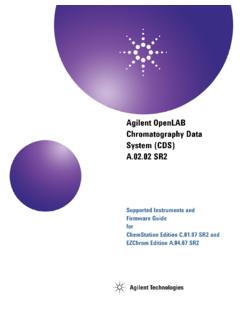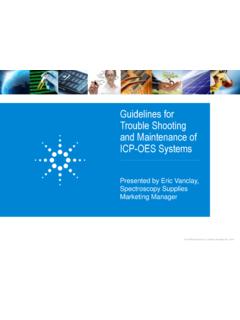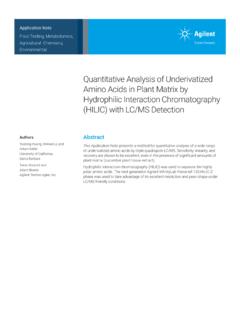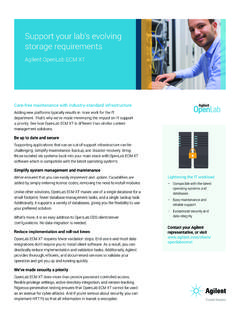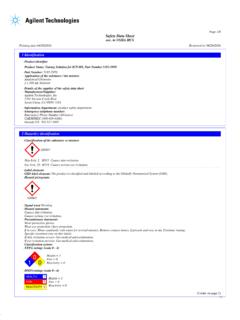Transcription of Agilent Hi-Plex Ligand Exchange Columns
1 Data SheetInstallation column connectionsHi-Plex Columns are supplied with industry standard end fittings. Only compatible nuts and ferrules should be used. Nuts should be tightened finger tight, then 1/4 turned using a wrench. To avoid loosening column end fittings, wrenches must be used only on the outer column end fitting, marked A in Figure , the appropriate PEEK Fingertight fitting can be used, ensuring that there is no dead volume between the tube and the end fitting Hi-Plex Ligand Exchange Figure 1. Wrench eluentHi-Plex Columns are supplied containing UHP water. Columns are securely sealed with end caps which must ALWAYS be replaced when the column is disconnected from the system to prevent the column from drying conditioningHi-Plex Columns must be run at elevated temperatures (see Table 1).
2 The mobile phase should be run at mL/min and the column heating device switched on. When the column reaches the desired operating temperature the flow rate may be increased gradually to the required level. Care should be taken to ensure that the maximum flow rate of the column is not exceeded. Hi-Plex Columns should not be subjected to sudden changes in flow no circumstances should the column heating device be left switched on with no flow through the phasesAll mobile phases used must be of high purity and should be filtered (< m filter) and degassed before use. The mobile phase should be degassed in the vessel used as mobile phase reservoir. Water is more effectively degassed at elevated temperature.
3 Hi-Plex resins may be used with up to 5% v/v alcohol, or up to 30% v/v acetonitrile in the mobile phase. The system should be thoroughly purged with the mobile phase before attempting to connect the preparationSample solutions should be filtered prior to use. Solvent precipitation or extraction may be used to remove protein, lipid, and other biological contaminants. Ion Exchange should be used to remove ionic contaminants where appropriate. Guard Columns should be replaced on a regular basis to ensure contamination of the analytical column does not column eficiency testingIt is recommended that a simple chromatographic test is used to monitor the performance of the column on a regular basis. Ideally, the test should replicate that of the enclosed Column Performance Report.
4 Minor differences in peak shape or retention time may be due to variations in system configurations and hold up volumes. In the case of major differences, the column should be re-tested with fresh mobile phase after checking the system thoroughly for possible sources of loss of efficiency such as excessive lengths of connection tubing, or injector guard Columns are strongly recommended in all cases. Extreme care should be taken during sample preparation to minimize the risk of introduction of particulate, ionic, or hydrophobic contaminants. Hi-Plex Columns are quite resilient and can sometimes be recovered following a loss in performance (see Column cleanup). Hi-Plex is a low backpressure column. System pressure should not be used as an indicator of column pressure.
5 Performance, not pressure, is the primary indicator of column cleanupResin-based Columns contaminated or damaged during use, can sometimes be the operating pressure has increased the column should be flushed with HPLC grade water in the reverse direction for at least 12 hours at the appropriate operating temperature. This may remove particulate contamination at the inlet of the strongly retained contaminants, the addition of a small amount of organic modifier to the mobile phase can be beneficial (<30% v/v acetonitrile, <5% v/v methanol or other alcohol).Contamination with other counter ions is a more serious problem. Extensive flushing of the column with a M solution of the appropriate nitrate salt (or M sulfuric acid in the case of hydrogen forms) can help to regenerate the resin (see Tables 1 to 3).
6 Due to differences in swell of the resin in differing counter ion forms, it is not recommended to attempt to change the ionic form of a packed Columns should ideally be run at reduced flow ( mL/min) at the required operating temperature when left Columns are stable for shipping, day-to-day handling, and short-term storage at room temperature. However, the column s performance will deteriorate over the course of months or years if stored at room temperature. For long-term storage, the column should be flushed with HPLC grade water at the required operating temperature. The flow rate should be slowly reduced to mL/min, and the column heating device switched off. When the column has cooled, it can be removed from the system, and the end plugs should be replaced.
7 The Columns should be refrigerated at approximately 4 C, but under no circumstances should they be allowed to Columns are covered by a warranty for 60 days following delivery. Agilent Technologies cannot accept liability for deterioration or loss of column performance as a result of improper handling or 1. Description and recommended operating conditions ( Hi-Plex Ca and Hi-Plex Pb).MatrixHi-Plex CaHi-Plex CaHi Plex Ca (Duo) Hi-Plex PbMonodisperse, Sulfonated Styrene/DivinylbenzeneIonic FormCalciumCalciumCalciumLeadCrosslink Content8%8%8%8%Particle Size8 m8 m8 m8 mDimensions250 mm 250 x mm300 mm300 mm300 mm 100 mmMax Flow mL/min1 mL/min1 mL/min1 mL/minTypical Flow mL/minTemperature80 to 90 C80 to 90 C80 to 90 C70 to 90 CMax Pressure*50 bar50 bar50 bar50 barTypical Pressure12 bar12 bar27 bar7 bar/6 barEluentWater or 30 % acetonitrileWater or 30 % acetonitrileWaterWaterModifiers<5% alcohol, <30% M Ca(NO3) M Ca(NO3) M Ca(NO3)2 M NaNO3 (1.)
8 49 v/v) M Pb(NO3)2 Storage EluentWater Water WaterWater* Remember to account for system pressures when assessing whether Pmax is being exceeded. Pmax can be calculated by subtracting the instrument pressure with no column installed from the instrument pressure with a column 2. Description and recommended operating conditions ( Hi-Plex K and Hi-Plex Na).MatrixHi-Plex KHi-Plex Na (Octo) Hi-Plex NaMonodisperse, Sulfonated Styrene/DivinylbenzeneIonic FormPotassiumSodiumSodiumCrosslink Content8%8%4%Particle Size8 m8 m10 mDimensions300 mm300 mm300 mmMax Flow Rate1 mL/min1 mL/minTypical Flow mL/minTemperature80 to 90 C80 to 90 C80 to 90 CMax Pressure*50 bar50 bar25 barTypical Pressure22 bar17 bar16 barEluentWaterWater or M NaOHWaterModifiers<5% alcohol, <30% M M M NaNO3 Storage EluentWaterWaterWater* Remember to account for system pressures when assessing whether Pmax is being exceeded.
9 Pmax can be calculated by subtracting the instrument pressure with no column installed from the instrument pressure with a column 3. Description and recommended operating conditions ( Hi-Plex H).MatrixHi-Plex HHi-Plex HHi-Plex HMonodisperse, sulfonated styrene/divinylbenzeneIonic FormHydrogenHydrogenHydrogenCrosslink Content8%8%8%Particle Size8 m8 m8 mDimensions250 mm300 mm300 mm 100 mmMax Flow mL/min1 mL/minTypical Flow mL/minTemperature40 60 C (acid) 60 70 C (water)40 60 C (acid) 60 70 C (water)40 60 C (acid) 60 70 C (water)Max Pressure*50 bar50 bar50 barTypical Pressure16 bar25 bar20 bar / 12 barEluentWater or M H2SO4 Water or M H2SO4 Water or M H2SO4 Modifiers<5% alcohol, <30% M M M H2SO4 Storage EluentWaterWaterWater* Remember to account for system pressures when assessing whether Pmax is being exceeded.
10 Pmax can be calculated by subtracting the instrument pressure with no column installed from the instrument pressure with a column information is subject to change without notice. Agilent Technologies, Inc. 2016, 2019, 2020 Printed in the USA, September 24, 2020 5991-6743 ENAgilent ordering informationFor more information on our products, visit our web site at.
